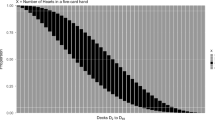Abstract
We propose a methodology to draw a representative sample from a population with a small fraction of potential customers for a certain product or a service. The objective is to increase the expected number of potential customers in a sample of fixed size representing the whole population. The method also provides a useful way of incorporating subjective judgement and uncertainty into the sampling plan. This approach has produced very satisfactory results for rare event problems in a number of telecommunications applications.
Similar content being viewed by others
References
Cochran, W. G. (1977).Sampling Techniques. New York: John Wiley & Sons.
Berger, J. O. (1985).Statistical Decision Theory and Bayesian Analysis Second Edition, New York: Springer-Verlag.
Johnson, N. L., and Kotz, S. (1970).Continuous Univariate Distributions. 2, New York: John Wiley & Sons.
Urban, G. I., Hauser, J. R., and Roberts, J. H. (1990). “Prelaunch Forecasting of New Automobiles,”Management Science 36, 401–421.
Weerahandi, S., and Zidek, J. V. (1983). “Elements of Multi-Bayesian Decision Theory,”The Annals of Statistics 11, 1032–1046.
Zellner, A., and Rossi, P. E. (1984). “Bayesian Analysis of Dichotomous Quantal Response Models,”Journal of Econometrics 25, 365–393.
Author information
Authors and Affiliations
Rights and permissions
About this article
Cite this article
Weerahandi, S., White, R.G. A Bayesian survey technique for rare subjects. Marketing Letters 3, 39–47 (1992). https://doi.org/10.1007/BF00994079
Issue Date:
DOI: https://doi.org/10.1007/BF00994079




